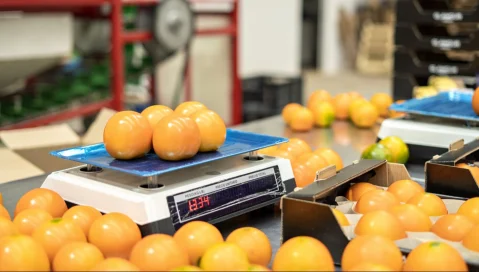Net Weight Vs. Gross Weight: Explaining the Differences, Calculations and Purposes
Net Weight Vs. Gross Weight: Explaining the Differences, Calculations and Purposes
Net Weight Vs. Gross Weight: Explaining the Differences, Calculations and Purposes
22 Feb 2024
John McCurdy
Typically, when you want to find out the weight of an item, you just place it on a scale and record the reading. But as a professional in the exacting world of consumer goods manufacturing, you know it’s not so simple as that—a product could have multiple weight measurements, depending upon exactly what’s included and how the figure will be used.
Two immediately recognizable but also potentially confusing terms used to describe a product's weight are net weight and gross weight. While they sound similar and sometimes only differ by a very small amount, it’s still important to distinguish between them, as each has specific contexts in which it’s relevant and thus must be tracked and labeled.
To help you get a firm grasp on their meanings and use cases, we’ll examine the two and compare net weight vs. gross weight while also sharing key formulas and industry-specific considerations. Lastly, we’ll touch on the purpose-built features of manufacturing software that can help you calculate, track and label net weight and gross weight.
Net Weight, Explained
The net weight of a product is the weight of the product itself, excluding any packaging, containers and/or packing material (dunnage) in which it would be shipped or sold. So this measurement reflects the total weight of the raw materials that went into the production of the item (or items), as well as how much the consumer will receive upon purchase.
To calculate net weight, you can weigh the product alone. Alternatively, you can weigh the product with its packaging, containers and dunnage, then weigh those components alone—a figure known as tare weight—and subtract it from the total weight.
Net weight = total weight – tare weight
Net weight is particularly important in the food and beverage industry, as it is customary to print the figure on product packaging and is necessary for calculating how many servings are contained in the package. It also affects the bill of lading for air freight, as well as how much freight you can ship at a time. Finally, carriers need it to calculate certain fees.
Gross Weight, Explained
When you need to account for packaging, containers and dunnage in addition to the product, you’ll be looking for gross weight. For this measurement, it may be as simple as putting the product in its packaging on a scale—but keep in mind that if you’re shipping in pallets, crates, retail displays or serialized shipping containers, those must be included.
Alternatively, if you already have the net weight and the tare weight, you can simply add the two together to calculate gross weight (though the note about pallets, crates, displays and shipping containers above may still apply depending on your circumstances).
Gross weight = net weight + tare weight + weight of all containers
Gross weight is typically the primary variable that affects shipping costs, with heavier shipments being more expensive. It’s also important to have accurate gross weight measurements due to the fact that vessels have a maximum cargo weight that can be safely carried. Lastly, gross weight is required for your bills of lading (BOLs; see below).
Key Software Functionalities for Handling Weights
With those distinctions made clear, we can devote some attention to how purpose-built software, like an enterprise resource planning (ERP) system, can facilitate handling all manner of weights with features like:
Weigh scale integration - Collecting weight data automatically in digital format is ideal, as that helps to prevent errors and saves employees time. That’s possible when you integrate your weigh scales with your ERP system.
Labeling and printing tools – Clearly labeling your items’ weights is necessary to ensure that all of your supply chain partners have easy access to this information. The right ERP will let you configure and print labels, even from a mobile device.
Catch weight functionality – Products with a variable weight (frequently referred to as catch weight), such as dairy, meat, poultry and seafood items, require this ERP functionality to accurately measure and record the net weight of the goods.
Electronic data interchange (EDI) integration – Many retailers, especially larger established chains, require that transaction data—including the net and gross weight of products—is submitted via EDI, making this a must-have feature of ERPs.
Bill of lading tools – As mentioned above, gross weight is required for all BOLs, so it’s best to have functionality to handle those within your ERP system, where weight measurements can easily be pulled from the database and applied.
When evaluating your options for ERP systems, prioritize those that were designed specifically for the industry in which your company operates. That way, you can secure any additional functionalities you’ll need for recording and conveying weight measurements, like the dedicated packing and shipping features of an advanced food ERP.
Aptean: Partner With a Provider That Can Make Your Lift Lighter
Having now learned (or refreshed your understanding of) the difference between net and gross weight, as well as the importance of both measurements and the utility of an ERP solution in their handling, you may be wondering where to turn to better equip your company on this front. We can share several reasons why Aptean is an ideal provider.
Whether you’re looking for your first ERP, ready to make an upgrade or want to round out your tech stack with a complementary solution like product lifecycle management (PLM) or route optimization software, we’ve got you covered. And we’re eager to work with you as a long-term partner, offering support during implementation, training and ongoing service.
Our team also has deep expertise in our target markets, including the food, beverage, process, apparel and discrete manufacturing industries. We really “speak your language” thanks to decades of collective experience, and our professionals understand the unique manufacturing challenges that you face and how to overcome them.
Finally, we can help your company realize the scalability, cybersecurity and data protection that the modern business landscape demands with a flexible cloud deployment on the Software as a Service (SaaS) model. This lightweight approach puts less burden on your internal IT teams, as all maintenance and updates are taken care of automatically.
If you’re ready to learn more about our industry-tailored ERPs and how they can equip your business to handle not just net weight and gross weight but much more, contact us today.
Related Content


Sind Sie bereit, Ihr Unternehmen grundlegend zu verändern?
Wir bieten Ihnen die spezialisierte Branchensoftware, die Ihre Organisation voranbringt.






